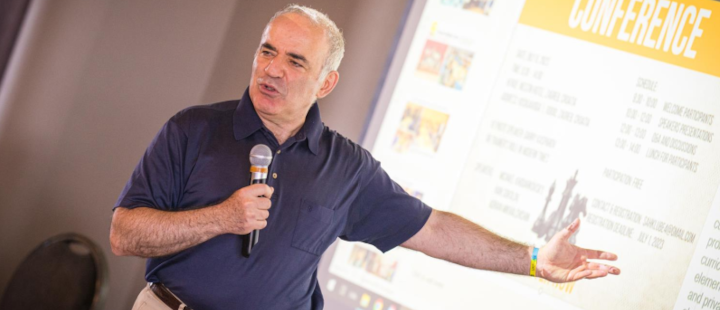

This article is a reprint. You can read the original at Kasparov Chess.
By Tiberiu Georgescu
“8/4/2023 – The inaugural KCF European Trainers Conference brought together around 150 trainers from more than 25 countries. The distinguished speakers, including Michael Khodarkovsky, Ivan Sokolov, Adrian Mikhalchishin, and Garry Kasparov, shared their expertise, enriching the conference with valuable insights and experiences. | Photos: Lennart Ootes / Anastasiya Karlovich / Kasparov Chess Foundation
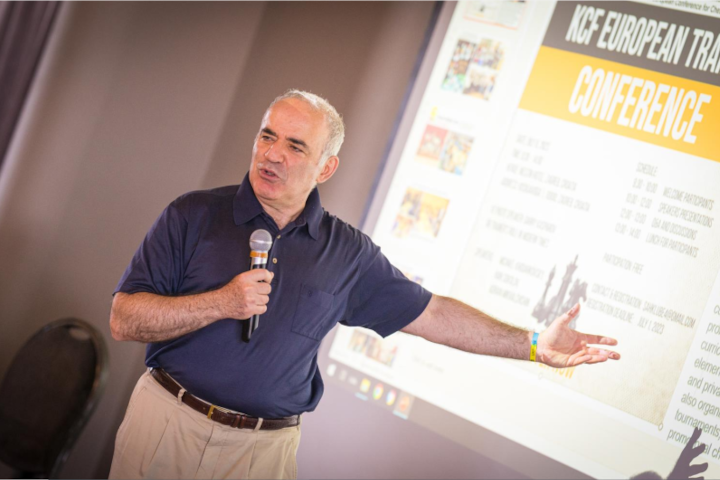
The inaugural KCF European Trainers Conference, hosted and sponsored by the esteemed Kasparov Chess Foundation, in collaboration with the European Chess Union Trainers Commission, the Kasparov Chess Foundation Adriatic and the European Chess Academy, kicked off with great enthusiasm. The event brought together around 150 trainers from more than 25 countries across four continents, and took place at the prestigious Westin Hotel in Zagreb, the same venue as the Grand Chess Tour’s third stage — the SuperUnited Rapid & Blitz.
The moderator, Grandmaster Cristian Chirilă, a trainer himself and director of the program at the Missouri State University, USA, set the stage for an engaging and insightful conference, introducing a lineup of distinguished speakers who are renowned in the world of chess coaching and organization.
Speakers:
- Michael Khodarkovsky – Training the young players
- Ivan Sokolov – Training the professionals
- Adrian Mikhalchishin – Women in Chess
Keynote speaker:
- Garry Kasparov – Trainers’ role in modern times
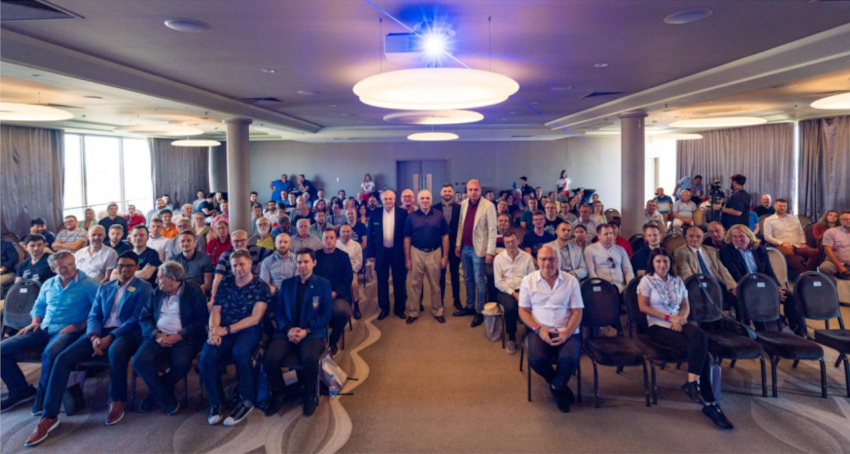
Honoring the Kasparov Chess Foundation’s Legacy
Commencing the conference, the attendees celebrated the 21st anniversary of the remarkable Kasparov Chess Foundation, which has played a pivotal role in discovering and nurturing exceptional chess talent.
The first speaker: Michael Khodarkovsky
As the morning session unfolded, the stage welcomed Mr. Michael Khodarkovsky, a highly accomplished chess coach, writer, and organizer. Khodarkovsky’s impressive achievements include serving as coach of the US Youth World Team from 2005 to 2017, the head coach and captain of the US Olympiad Women’s team from 2003 to 2013, contributing to their historic medal victories in 2004 and 2008 respectively. He has been an integral part of Garry Kasparov’s coaching staff during the 1995 and 2000 World Championship matches, as well as the legendary encounters against IBM’s Deep Blue in 1996 and 1997. Currently, as FIDE Vice President, FIDE Senior Trainer, and President of the Kasparov Chess Foundation, Khodarkovsky commands immense respect and admiration within the world’s chess community.
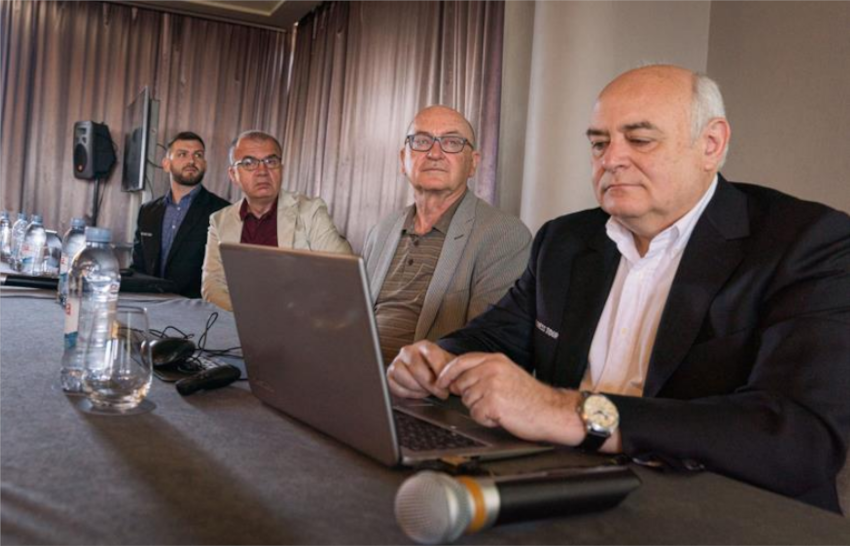
From left to right: Cristian Chirilă, Ivan Sokolov, Adrian Michalchishin, Michael Khodarkovsky
Michael Khodarkovsky’s conference presentation: Building a strong chess organization and nurturing talent
Michael Khodarkovsky delivered a compelling presentation that offered valuable insights into building a robust multi-level organization and fostering healthy growth. With a focus on the journey of their organization to the top of the chess world, Khodarkovsky shared his experiences, highlighting how they overcame key challenges and achieved success. Notably, he emphasized the personal connections formed with students, particularly those from the Foundation’s Young Stars program, showcasing the deep bond that goes beyond their chess achievements. Additionally, he provided insights into their student selection process and discussed the objectives and approach they employ to assist young players.
Building strong connections: Nostalgia and KCF Family
During his presentation, Khodarkovsky’s gave a personal touch as he shared heartfelt anecdotes about the students of the Young Stars program. He displayed a nostalgic affection for the memories and experiences they had together, emphasizing that they were not merely champions but an integral part of the Kasparov Chess Foundation family. This connection extends beyond their time as students, illustrating the lasting impact and meaningful relationships formed through their chess journey.

From left to right: Michael Khodarkovsky and Garry Kasparov with the program’s Grandmasters: Jonas Buhl Bjerre (Denmark), Christopher Yoo, and Abhi Mishra (USA)
After Garry Kasparov retired as a professional player in 2005, Khodarkovsky was “released” from his duties and was able to dedicate his career to other causes. In the same year, he became the coach of the US World Youth Team and for the next 13 years, many of his students achieved impressive results. Along with his colleagues from the US coaching staff, he managed to bring home numerous champions titles at both continental and world chess championships.
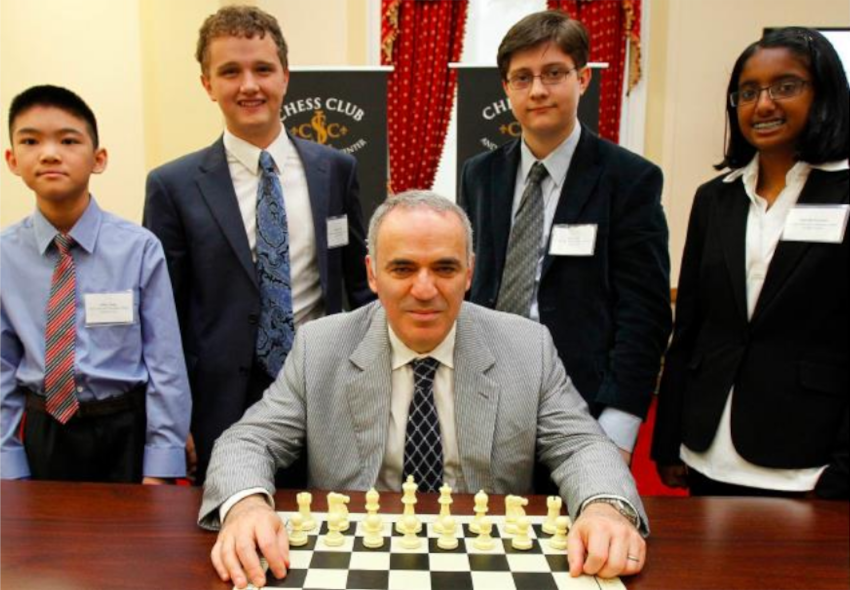
KCF has partnered with The Chess Club and Scholastic Center of Saint Louis, in its Young Stars – Team USA program. The program has helped develop a number of world champions from across the country, including GMs Jeffery Xiong, Kayden Troff and Sam Sevian. In the photo above, the three of them, together with WIM Ashritha Eswaran, accompanied the great Garry Kasparov during a visit to the US Congress in Washington DC in 2014, where some congressmen could actually see the young Grandmasters’ talent.
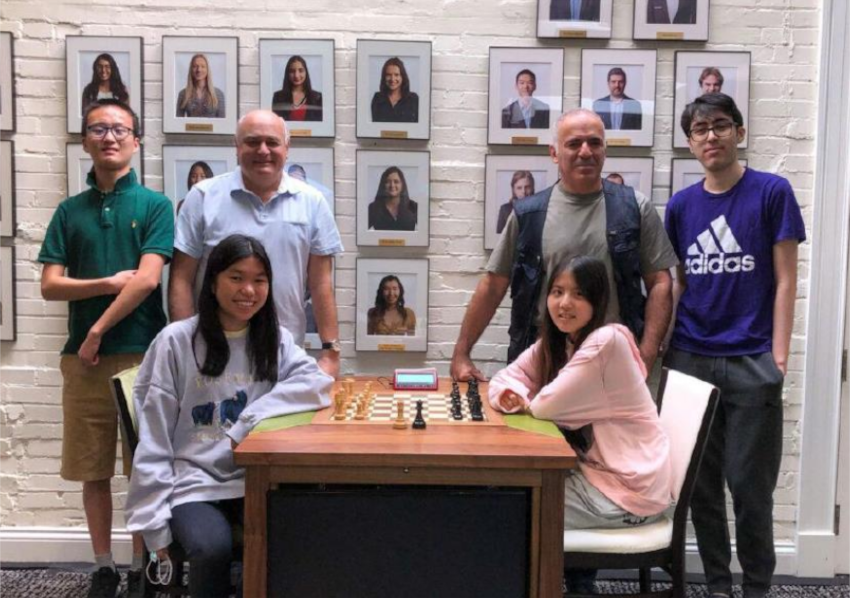
Photo taken during the training session at the Saint Louis Chess Club: Cristopher Yoo, Carissa Yip, Rochelle Wu and Brandon Jacobson with their mentors
Global Youth program: 2019-present
Since 2019, the Young Stars training program became global, organizing the first session in Zagreb. Last year the program was dedicated to Ukrainian talented kids.
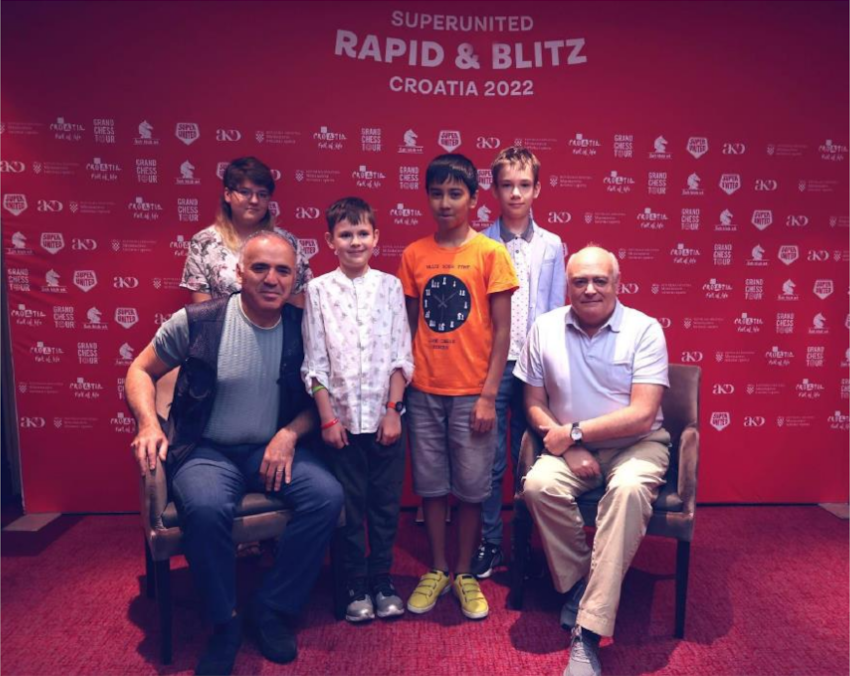
From left to right, the young champions: Mariya Manko, Kirill Nezhentsev, Teimur Toktomushev, Ihor Samunenkov
This year, two training sessions took place, one in Vienna and one in Zagreb.
Selecting promising students: Key attributes
Khodarkovsky provided insights into their students’ selection process, focusing on key attributes they consider when identifying promising young talents. These attributes include:
- age – typically between 9 and 13;
- results and rating in comparison with other players of similar age;
- a meticulous scouting process that involves studying the potential students’ games.
Khodarkovsky explained training methods and presented some examples which were used to evaluate students during training sessions. In the picture below, you can see Abhimanyu Mishra at work, the youngest grandmaster in chess history. Meantime, the youngest generation of the program is posing in KCF’s headquarters in New York, upon conclusion of their first session with Garry Kasparov and Michael Khodarkovsky.
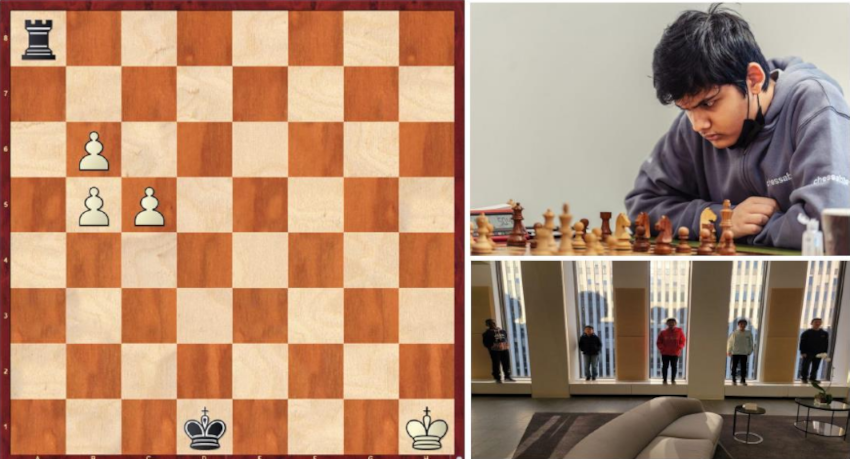
White to move
In order to solve studies such as the ones shown above and below, instructors allow students to work on those from 10-15 up to 30 minutes, depending on the difficulty level. The students find not only the right move, but the sequence of moves to compliment the main idea of the study. The main line and the most important sidelines have to be written on paper.
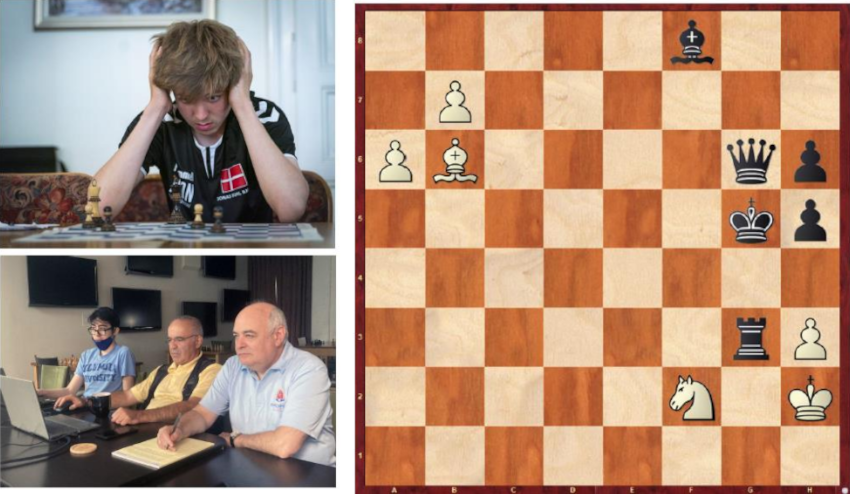
White to move
Objectives and progress assessment
The presentation further shed light on the objectives set for the students. The aim for young players is to achieve the title of Grandmaster by no later than 16 to 18 years old, reflecting their commitment to fostering rapid growth and development. Khodarkovsky addressed an important question regarding progress assessment, explaining that they typically evaluate the student’s progress after 6–12 months of collaboration. During the course of the program, the Foundation provides personal training support to those students who demonstrate strong effort and steady progress.
If there is insufficient progress, then they provide detailed feedback and recommendations to go back on track. Pausing the collaboration does not indicate a permanent end, as trainers of the program continue to monitor performances of the students with the aim of resuming their work.
By outlining their student selection process, objectives, and approach to progress assessment, Khodarkovsky provided a glimpse into the thoughtfulness and dedication invested in developing young players. As the audience absorbed these insights, they gained a more in-depth understanding of the intricacies involved in building a successful chess organization and fostering the growth of future champions.
Adrian Mikhalchishin: Training for women’s chess
Continuing the conference’s insightful discussions, GM Adrian Mikhalchishin took the stage. A trainer of champions and legends, Mikhalchishin built an impressive coaching repertoire, having worked with world champions such as the great Anatoly Karpov, Maia Chiburdanidze, and the Polgar sisters. With a track record of teaching world-class grandmasters, Mikhalchishin’s expertise and prolific authorship made him a highly regarded figure in the chess community. He shared his knowledge on training methods specifically tailored for women’s chess, adding depth to the conference program.
10% of chess players are women
One of the primary goals of the chess community is to discover methods to more effectively engage female chess players and create an improved chess environment. Currently, the number of female chess players stands at around 10%. In order to bridge the performance gap between the genders, the chess community is in need to form a more balanced representation.
An intriguing observation has been made regarding the divergent interests in higher education between male and female top chess players. It appears that female top chess players tend to dedicate time to pursuing higher education, while their male counterparts tend to prioritize a sole focus on chess.
It is essential to foster an inclusive environment in which all players, regardless of gender, have equal opportunities to excel and pursue their interests. By addressing the challenges and disparities faced by female chess players, we can work towards creating a more balanced and diverse chess community, ultimately benefiting the game as a whole. Open and respectful dialogue, as well as ongoing efforts to promote equality and inclusivity, will be instrumental in achieving this goal.
Exploring talent identification with Ivan Sokolov
The stage welcomed Grandmaster Ivan Sokolov, an elite-level player and revered coach. Renowned for his exceptional achievements as a player, Sokolov seamlessly transitioned into coaching, assisting some of the world’s top junior talents, including Alireza Firouzja, Parham Maghsoodloo, Salem Saleh, Bogdan Deac or Jorden van Foreest. As the captain of Uzbekistan, Olympiad champions in 2022, and the current coach of the Romanian Olympiad team, Sokolov shared his invaluable insights on talent identification, enriching the conference with his wealth of experience.
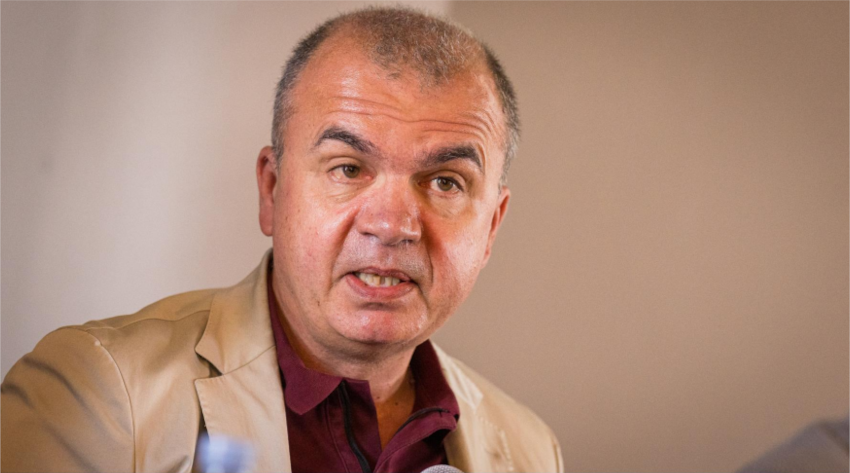
In a captivating keynote speech at a recent conference, Ivan Sokolov delved into the fascinating realm of chess and explored the potential of young players, specifically those with a rating of 2550 and above. Drawing from his extensive experience and knowledge, Sokolov shared insights into the qualities and attributes necessary for these talented individuals to reach the pinnacle of the chess world. By examining the traits of dedication, tenacity, and understanding the position, Sokolov shed light on the path to becoming a top player.
Recognizing talent and the road to success
As a player who himself stepped away from professional chess in 2013, Sokolov possessed a unique perspective on identifying talent and nurturing it into excellence. He emphasized the importance of recognizing a strong player who possesses the potential to become a top performer. Sokolov highlighted three key abilities that lay the foundation for success: dedication, tenacity, and understanding the position.
- The power of dedication and hard work
Sokolov underscored the significance of dedication and hard work, both before and after tournaments. Young players must be willing to invest countless hours honing their skills, analysing games, and continuously seeking improvement. Sokolov stressed that it is the unwavering commitment to constant progress that separates the good from the great.
- Tenacity: The will to succeed during the game
In discussing the importance of tenacity during rounds, Sokolov recounted memorable experiences where top players demonstrated an unwavering will to win. He highlighted instances where players managed to secure victories against seemingly unbeatable opponents by refusing to accept defeat. By showcasing resilience and an unyielding spirit, these players demonstrated their potential to rise above challenges and achieve remarkable results.
In the game below, a 15-year-old Alireza Firouzja managed to save the game despite being a piece down, which GM Sokolov defines as the talent of “refusing to die”, a key aspect of a player with top GM potential.
- Understanding the position and psychological disruption
Sokolov emphasized the significance of understanding the position and recognizing critical moments when a game cannot be saved by conventional means. At such junctures, Sokolov advocates for players to employ disruptive tactics that psychologically may unbalance their opponents. By introducing unexpected moves or strategies, players can create new opportunities and turn the tide in their favour, showcasing their ability to think outside the box and exploit the psychological vulnerabilities of their opponents.
- Case study: Kirill’s example and Magnus’ “anti-talent”
Sokolov provided insightful case studies to illustrate his points. He presented Kirill Shevchenko as an example of a young player who embodies dedication, tenacity, and a deep understanding of the game. By following these principles, Kirill demonstrated great potential for reaching the upper echelons of professional chess. The correct move is 32.h4!, which Kirill recently spotted during a training session.
“The difficulty of the exercise is that (after already playing quite a number of strong moves) the player needs to understand that:
- White does not have a win;
- Black does not really have moves;
- If White improves his king’s position/situation, the position will be winning” (GM Sokolov).
Sokolov finished his presentation in a very humorous way, by explaining that no system is perfect and everyone can be wrong sometimes! The coach of the 2022 Olympiad champions showed a game played by himself in 2008 against the young future world champion, Magnus Carlsen, who was only 14 years old at the time. Sokolov won easily and admittedly thought that there was nothing special about that kid. Sokolov confessed to the conference attendees how wrong his assessment of the young prodigy was. The lesson we take away from this is that even the best trainers in the world can be mistaken in identifying talent.
Garry Kasparov: Trainers’ role in modern times
The much-anticipated moment arrived as the audience eagerly welcomed to the stage the legendary 13th World Champion, Garry Kasparov. Renowned for his unprecedented dominance in the chess world and his subsequent role in identifying and nurturing exceptional chess talents, Kasparov’s presence was a major highlight of the conference. As the mentor and coach of Magnus Carlsen in 2009, Kasparov’s profound insights and extensive knowledge captivated the audience. Kasparov emphasized the importance of understanding the transformation from classical training methods to the present-day approach.
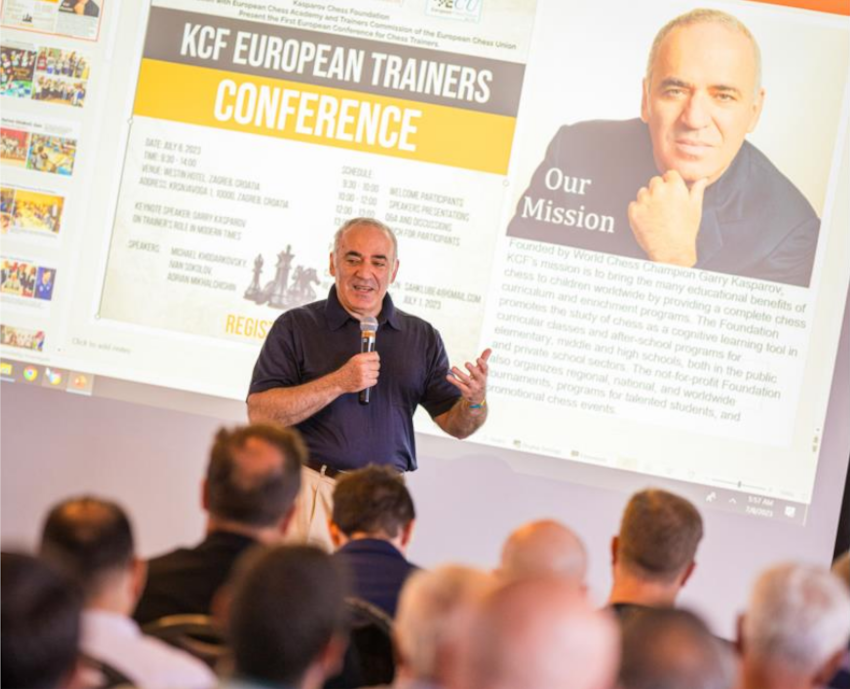
Reflecting on his meeting with Botvinnik in August 1973, when little Garry was only 10 years old, Kasparov reminisced about the profound impact it had on him and the deep nostalgia he feels to this day. This meeting symbolized a turning point and marked the beginning of significant changes in his chess training. After Kasparov became World Champion, he decided to continue the work and the organization became the Botvinnik-Kasparov School, which played a significant role in his chess journey.
Kasparov’s talk shed light on the evolution of chess training and the transformative role technology — particularly computers — has played in the game. With his unique perspective, Kasparov presented solutions while also highlighting key challenges that need to be addressed in the future.
The advent of computers and the training revolution
Kasparov identified computers as the primary catalyst for change in chess and training techniques. He highlighted how the influx of technology altered the game’s dynamics and the way players prepared for matches. Reflecting on his own experiences, Kasparov recalled the challenges he faced in the past when information was very limited. Then, players needed to study very well with the available information and have a deep and clear understanding of it. In contrast, the present era presents an overwhelming abundance of information, which could lead to a partial understanding and, at times, superficiality.

The impact of technology on chess players
“Magnus Carlsen is the player who is best resisting the pressure of the screen” (Garry Kasparov)
Kasparov emphasized the importance of resisting the allure of excessive engine time, noting that the best players are those who can maintain a healthy balance between online resources and over the board play. He raised thought-provoking questions about distinguishing rational decisions from irrational ones and the role of inspiration in the decision-making process. Kasparov advocated for a genuine passion for data collection and urged students to delve deeper into the game’s general rules rather than relying solely on machines. Kasparov emphasized the need to push young players to break barriers and challenge conventional thinking, highlighting that only a select few, such as Magnus Carlsen, truly excel in this regard.
The era of computer-assisted chess
Kasparov chronicled the pivotal moment in 1995 when he started using computers for calculation, heralding a new era of computer-assisted chess preparation, as detailed in Michael Khodarkovsky’s book — “A New Era: How Garry Kasparov Changed the World of Chess” (1997). He cited the 2021 Candidates match between Fabiano Caruana and Vachier Lagrave as an example of the modern use of technology in chess.
They both analysed the same lines with top performance computers, but somehow Vachier-Lagrave overlooked the best continuation.
Striking a balance between data acquisition and utilization
“A good 11 or 12-year-old chess player nowadays has more chess knowledge than Bobby Fischer”
Due to the access to huge amounts of information, a good 12-year-old chess player already may obtain more knowledge than Bobby Fischer or even Garry Kasparov himself used to have. However, playing good chess is not only about the amount of data, but also about the depth of understanding.
In the past, one of the greatest challenges faced by top players was the acquisition of information. Access to information was limited, requiring individuals to navigate through scarce resources. However, this limitation led to a deep understanding of the available information, as players made the most of what they had.
Now, we are confronted with an abundance of information. The digital era has ushered in a vast wealth of chess-related content, resulting in almost infinite resources at our fingertips. However, this abundance has also led to a partial understanding of the information available. With so much content to sift through, it becomes challenging to fully grasp and internalize all the available knowledge.
It is worth noting that the arduous process of obtaining information in the past fostered a greater level of seriousness and commitment among chess enthusiasts. The limited access to resources compelled individuals to engage deeply with the information they had, resulting in a more profound understanding of the game. Conversely, the ease with which information can be obtained in the present era has the potential to make us more superficial in our approach.
Ultimately, these findings highlight the contrasting dynamics between the past and present in terms of information acquisition and its impact on our approach to chess. While the past necessitated a focused and serious mindset due to limited resources, the present offers a wealth of information alongside the challenge of navigating and processing it effectively.
“Force kids to break the glass of the screen”
A recurring theme in Kasparov’s speech was the importance of finding a balance between acquiring vast amounts of data and effectively utilizing it. He stressed the necessity of maintaining hunger and enthusiasm for the game, steering clear of complacency and routine. Kasparov observed that players in the 2500-2600 rating range often lack endgame knowledge, making it essential to incorporate tests and challenges that encourage greater precision in their studies.
Lessons from Man versus Machine
Kasparov humbly acknowledged his own mistakes, highlighting the lessons he learned from his infamous match against Deep Blue in 1997. He acknowledged the superior calculation abilities of machines but pointed out that they lack the creative and sacrificial nature of human players. With the emergence of Alpha Zero, Kasparov recognized the existence of imperfect patterns in machine-generated moves, highlighting specific challenges such as the fight between the bishop and the knight.
The contrast between general rules and machine-based analysis is worth considering. While machines offer valuable insights and analysis, a strong foundation in general principles provides a solid framework for decision-making during the game. It is essential to understand the general rules and to separate the engines’ variations into: irrational chess that cannot be understood by humans and logical chess.
“Machine does not sacrifice”
An interesting affirmation made by the world champion gave me food for thought, as I asked myself the following questions: How do I define a sacrifice in chess? Or how does risk aversion affect our ability to sacrifice material? Garry Kasparov pointed out that computer chess engines don’t sacrifice, they just give some assets to get equal or even more assets in the future. Taking this into consideration, it seems to me that the definition of sacrificing material in a game can also be connected with some level of emotions, which of course are experienced only by human beings.
Garry Kasparov’s keynote speech at the conference left an indelible mark on all those in attendance. Through his captivating storytelling and insightful analysis, he shed light on the transformation of chess training and the influence of technology. Kasparov’s message emphasized the importance of striking a balance between data acquisition and utilization, fostering a deep understanding of the game’s fundamentals, and maintaining passion and hunger in the face of advancing technology. His words served as a call to action, encouraging chess enthusiasts to explore the complexities of the game beyond the superficial and embrace the profound knowledge that lies within.
Rarely does the legendary 13th World Chess Champion, Garry Kasparov, grace us with a presentation. This special occasion was a true feast for trainers — it was an exclusive privilege to listen to him, as he left everyone elated and content.

The KCF European Trainers Conference was a big success, uniting passionate coaches from around the globe. Just to mention a few of the highly accomplished chess trainers and players who attended: Zurab Azmaiparashvili, the current President of the European Chess Union; Arshak Petrosian, coach of the Armenian Olympic Team; and Alexander Motylev, a trainer of the Russian Olympic team trainer for decades who recently joined the Romanian Chess Federation. After the conference, during lunch, the trainers were able to communicate with each other, share their thoughts and plant the seeds for new projects.
The distinguished speakers, including Michael Khodarkovsky, Ivan Sokolov, Adrian Mikhalchishin, and Garry Kasparov, graced the stage and shared their expertise, enriching the conference with valuable insights and experiences. As the conference progressed, participants eagerly absorbed the wisdom imparted by these esteemed figures, fostering a collaborative environment aimed at elevating the world of chess coaching. As a chess trainer and Federation official, I can only hope for more such events to feed the hunger for chess knowledge.”

